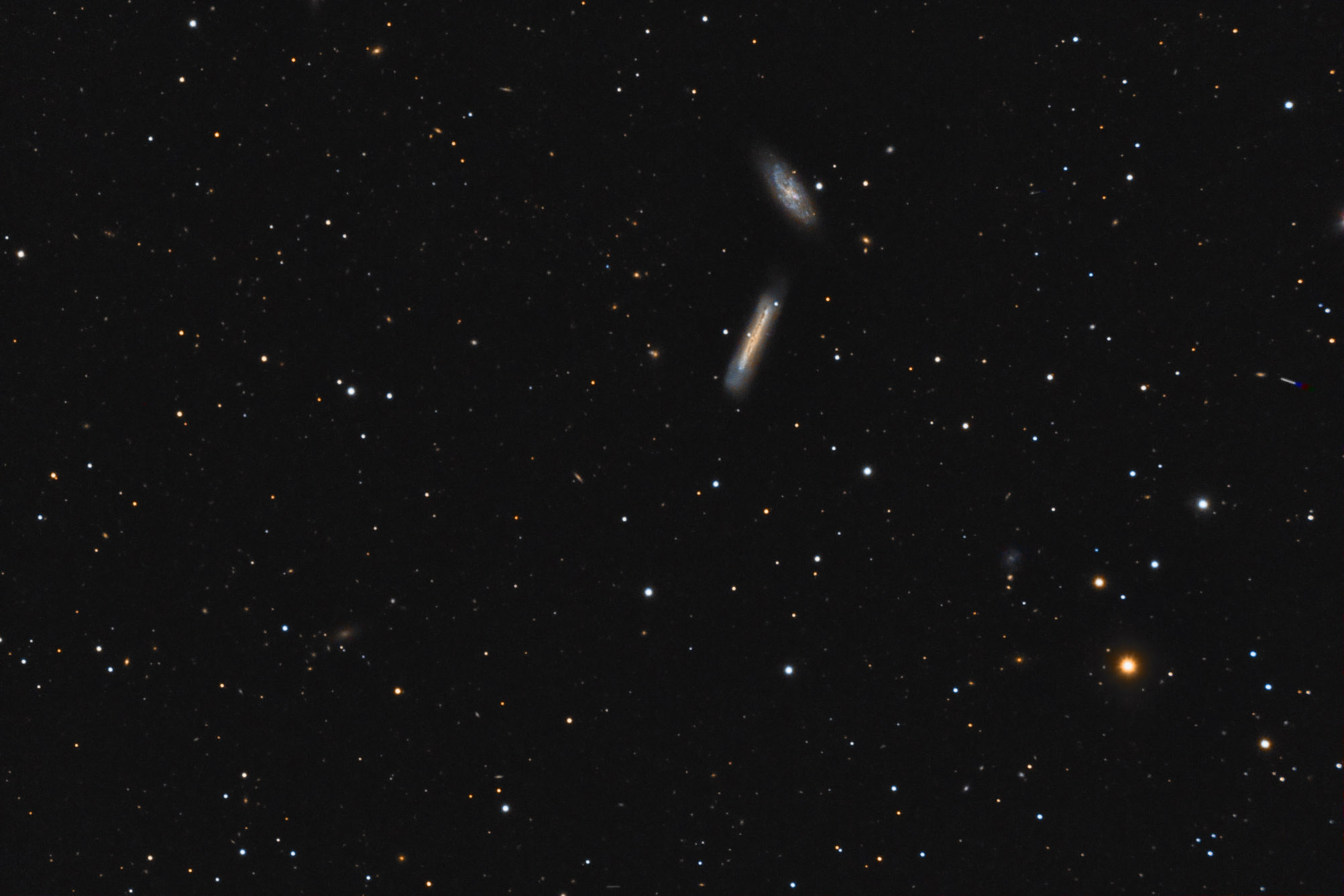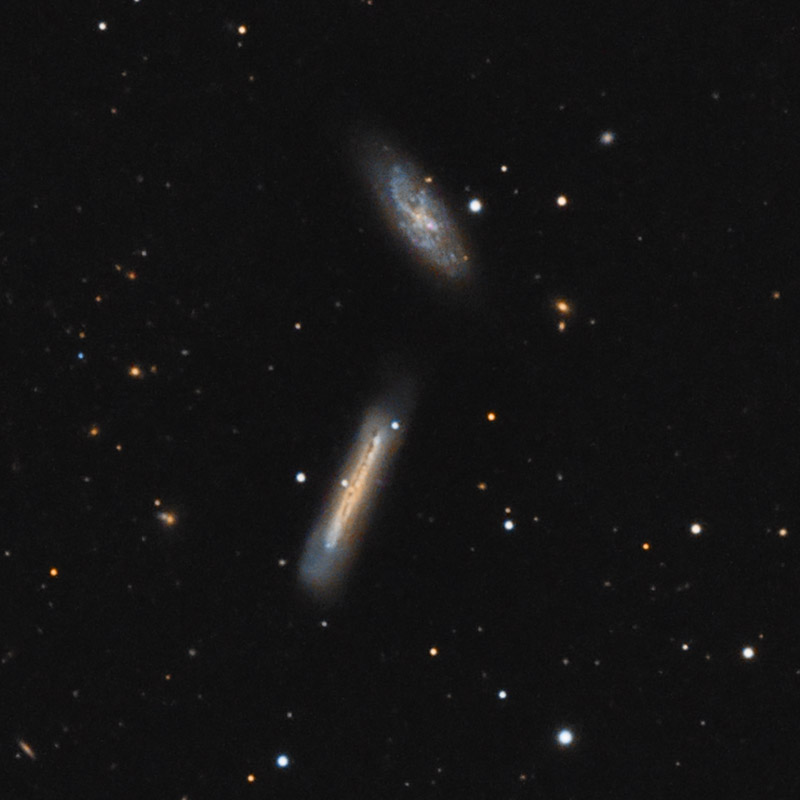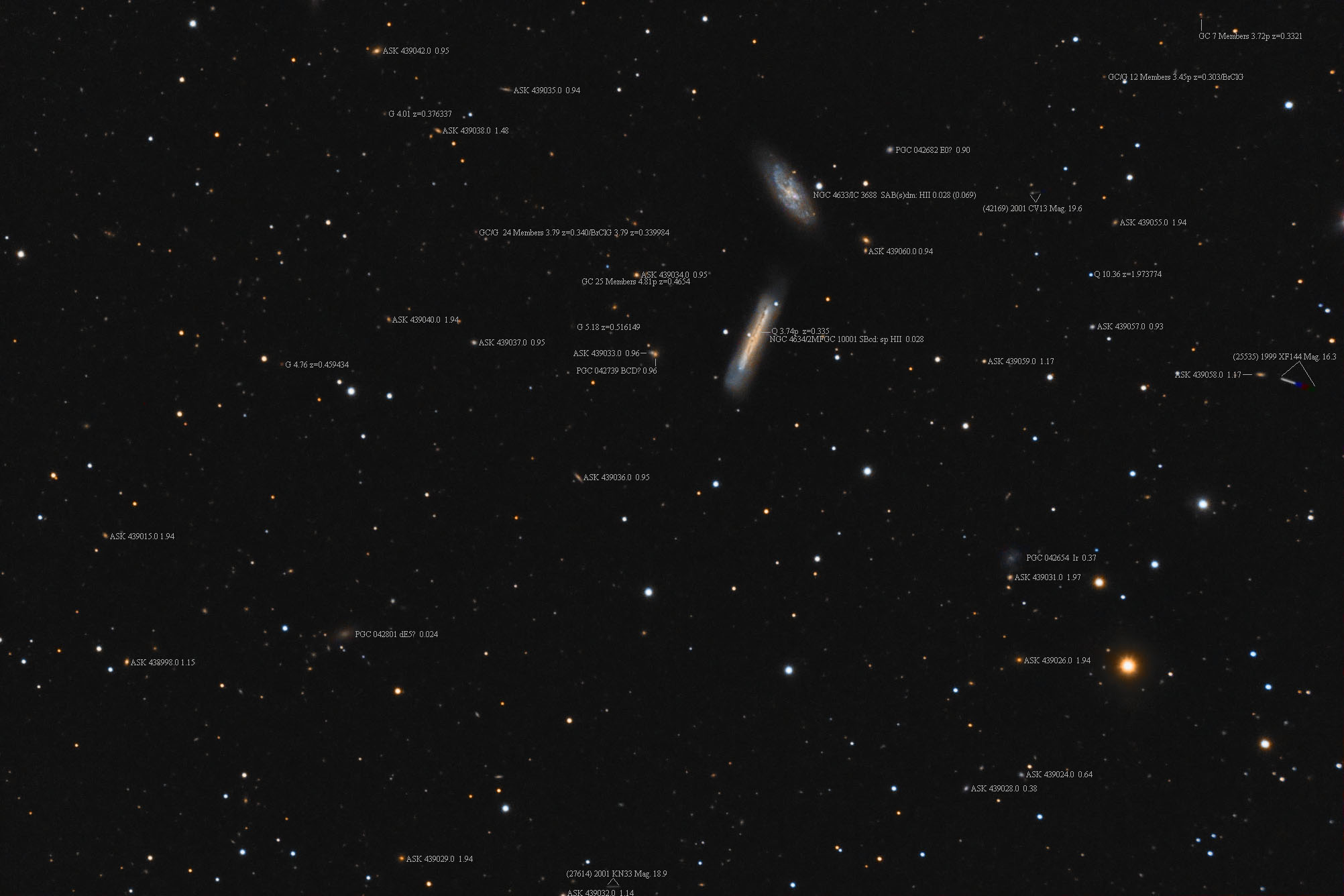Object name: NGC4633Designation(s): NGC4633, NGC4634, NGC 4633 is a strange disk galaxy possibly interacting with NGC 4634. The pair are located in southern Coma Berenices. Their distance is difficult to determine. By redshift, both are about 28 million light-years distant. Only NGC 4633 has a non-redshift measurement that comes in at 69 million light-years. Quite a difference. If they are interacting then NGC 4634 could also be about 69 million light-years distant. While I can't find an HST image of NGC 4633 there is one for NGC 4634. https://www.spacetelescope.org/images/potw1238a/ The text puts it at "about 70 million light-years". The pair are members of the Virgo Cluster though are on the outskirts of it as most spirals are. Radial velocities of Virgo Cluster members vary drastically with some even blue shifted indicating high orbital velocities are common in the cluster. Thus it isn't unusual that redshift gives erroneous values. Using 69 million light-years I get a size for NGC 4633 of 50,000 light-years and 71,000 for NGC 4634.
Both appear distorted by their interaction. NGC 4633 is classified at NED as SAB(s)dm: while Seligman says SBd?. The NGC Project leaves off the question mark. I classify it as "A Mess" though that isn't a valid classification. Still, it describes it better to my eye. Likely it was a much better organized barred spiral before it had a run-in with NGC 4634. Seen edge-on NGC 4634 seems to be a somewhat ordinary edge on galaxy within an oddly unsymmetric halo. In some ways, it resembles the Hamberger Galaxy, NGC 3628. Though its dust lane is also far from symmetric extending beyond the disk and into the halo to the northwest and breaking up and disappearing before reaching the southeast end of the inner galaxy. The HST image doesn't go deep enough to show much of the halo, unfortunately. Also, its color filters result in a somewhat false-color image missing the reddish hues that extend into the halo. Most halos are filled with new hot stars so tend to be blue but this one had a lot of cooler stars in it for some reason. Note I did push color on these two galaxies more than usual to bring out this oddity.
NGC 4633 was discovered by Edward Swift on April 27, 1887 and entered into the NGC catalog. Later on November 23, 1900, it was discovered by Arnold Schwassmann. Due to apparently different coordinates and Dryer not realizing it was a duplicate was entered into the IC catalog as IC 3688. NGC 4634 was discovered by William Herschel on January 14, 1787 but is not in either of the H400 observing programs. A Sloan image of this pair can be found at: http://skyservice.pha.jhu.edu/DR9/ImgCutout/getjpeg.aspx?ra=190.668663&dec=14.2988&scale=0.8&width=800&height=800&opt=&query=
NED shows a 20.1 magnitude quasar seen through NEG 4634. I point to its location though it is lost in the glare of the galaxy in my image. I can't even find it in the HST image linked to above. There are three asteroid trails in the image. One ran right over the 20.2 magnitude galaxy, SDSS J124212.15+142124.3. NED has no distance data for it. Just east of NGC 4634 is a pair of galaxies that have the same redshift so may be interacting. The red one, PGC 042739 is shown at NED as being BCD?. BCD normally stands for Blue Compact Dwarf. But given its color and distance is neither blue nor a dwarf. At least they added a question mark. It may be it got this designation before redshift was measured. Still, it is obviously quite red compared to its blue companion which should have been quite evident since the mid 50's when the first POSS survey was done in blue and red light. If there's another meaning for BCD I have never heard of it. https://ned.ipac.caltech.edu/level5/Sept02/Palco_BCD/Agpaz3.html
14" LX200R @ f/10, L=4x10' RGB=2x10', STL-11000XM, Paramount ME Related Designation(s):2MASS J12424093+1417443, 2MASX J12424098+1417451, 2MASXi J1242373+142126, 2MASXi J1242409+141745, 2MFGC 10001, AKARI J1242413+141741, ALFALFA 1-390, CGCG 099-111, CGCG 099-112, CGCG 100-001, CGCG 100-002, CGCG 1240.1+1438, CGCG 1240.2+1434, EVCC 1071, EVCC 1074, FAUST 3393, FAUST V168, GALEXASC J124237.31+142126.4 , GALEXASC J124240.86+141745.5 , HDCE 0720 NED189, HOLM 445A, HOLM 445B, IC 3688, IRAS 12401+1434, IRAS F12400+1438, IRAS F12401+1434, KPG 351A, KPG 351B, LCSB L0532O, LDCE 0904 NED230, MAPS-NGP O_436_0309689, MCG +03-32-085, MCG +03-32-086, NGC 4633, NGC 4634, NGC4633, NGC4634, NSA 142011, NSA 169938, NSA 169939, NVSS J124240+141746, PGC 042699, PGC 042707, SDSS J124237.37+142125.9, SDSS J124240.96+141744.9, SSTSL2 J124237.38+142125.9, UGC 07874, UGC 07875, USGC U490 NED49, USGC U490 NED50, UZC J124236.9+142125, UZC J124241.0+141746, VCC 1929, VCC 1932, [BEC2010] HRS 239, | | 

